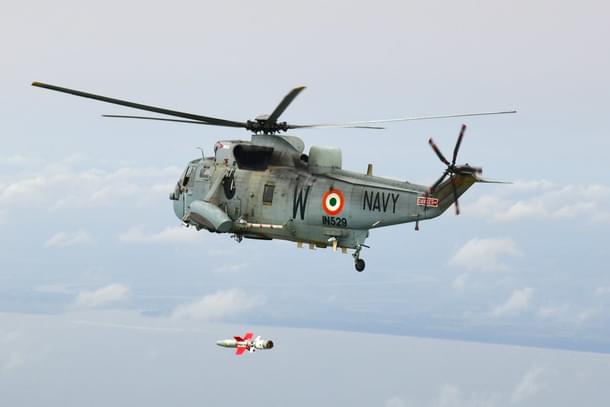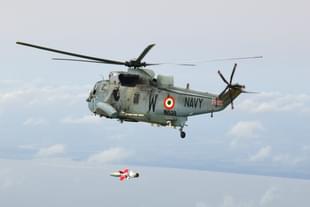Defence
Why The Latest Test Of India's Naval Anti-Ship Missile Was More Significant Than You Thought
Swarajya Staff
Feb 27, 2025, 03:06 PM | Updated 03:06 PM IST
Save & read from anywhere!
Bookmark stories for easy access on any device or the Swarajya app.


On 25 February 2025, the Defence Research and Development Organisation (DRDO) and the Indian Navy successfully carried out flight trials of the Naval Anti-Ship Missile–Short Range (NASM-SR) at the Integrated Test Range (ITR) in Chandipur.
This missile, India’s first indigenous air-launched anti-ship missile, is intended to replace the aging Sea Eagle missiles, which have been in service on Sea King Mk.42B helicopters since the 1980s. It reportedly has a range of 55 kilometres.
The NASM-SR was first tested in 2022, where it successfully demonstrated its sea-skimming capability, maintaining an altitude of just 5 meters above sea level before hitting its target with high accuracy.
During the latest test, NASM-SR was launched in Bearing-only Lock-on after Launch mode, meaning it did not have a pre-selected target before launch.
Once airborne, the missile began scanning a predefined search area using its onboard sensors to detect potential targets. It initially locked onto a larger target within this zone based on programmed parameters.
As the missile continued its flight, a high-bandwidth two-way datalink transmitted real-time data, including live images from its Indigenous Imaging Infra-Red (IIR) Seeker, back to the pilot. This allowed the pilot to monitor the missile’s trajectory and assess the detected targets in real-time. The Man-in-Loop feature enabled the pilot to intervene and make targeting decisions mid-flight.
Approaching the initially selected large target, the pilot identified a smaller, hidden target within the vicinity. Using the datalink system, the pilot commanded the missile to shift its lock from the larger object to this concealed target. The missile’s onboard guidance system immediately adjusted its flight path, redirecting itself toward the new target.
As the missile entered the terminal phase, the IIR seeker provided continuous target updates, allowing for refined trajectory adjustments. This ensured the missile maintained its lock and struck the smaller target with high precision, validating its ability to engage dynamic threats with in-flight retargeting.
"The missile uses an indigenous Fiber Optic Gyroscope-based INS and Radio Altimeter for its Mid-course guidance, an Integrated avionics module, Electro-Mechanical actuators for Aerodynamic and Jet vane control, thermal batteries and PCB warhead. It uses solid propulsion with an in-line ejectable booster and a long-burn sustainer," the Ministry of Defence said in a statement released after the test.
As India plans to retire its fleet of Sea King helicopters over the next few years, the NASM-SR to be integrated with platforms like the Sikorsky MH-60R and Hindustan Aeronautics Dhruv.
Adani Defence & Aerospace is responsible for its manufacturing.





